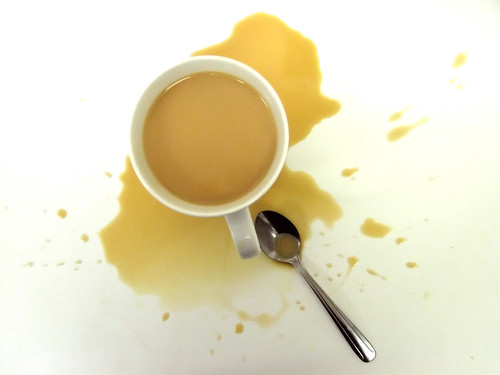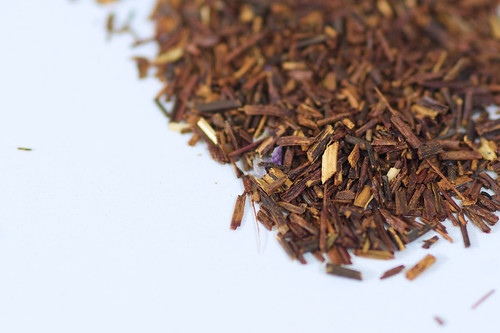Black Tea vs Green Tea: AGEs and ALEs
In previous posts, I've mentioned studies that have shown contradictory results for the effectiveness of green tea against advanced glycation end-products, or AGEs. At the time when the first post was written, I found five studies showing that green tea reduces AGE formation.
In a later post, I wrote that another in vitro study found yerba mate to inhibit AGE formation as effectively as aminoguanidine, which is one of the strongest anti-glycation drugs around. The bad news was that the same study found only a non-significant effect on AGEs from green tea. So what gives?
One possible reason for this discrepancy is dosage; perhaps low doses of green tea catechins are ineffective against glycation. Indeed, the yerba mate study used concentrations that were easily achievable in humans, whereas some of the others used stronger extracts. While a few cups of green tea may not do much in terms of AGEs, it's nonetheless promising that three of the five positive studies were in vivo. One of them was in diabetic rats and two of them were on normal rodents.
The problem with drinking copious amounts of yerba mate is that several reviews have found it to be carcinogenic. I will probably do another post on this, but based on my current knowledge, it looks like less than half a liter per day is not associated with an increased risk of esophageal cancer, while at higher levels the risk becomes clear. That means drinking enough yerba mate to inhibit AGEs may not be a smart choice.
If drinking 10 cups of green tea per day seems like a daunting task, rooibos tea is one alternative. We know that rooibos tea reduces lipid peroxidation, which causes advanced lipid peroxidation end-products, or ALEs. But there are no studies suggesting it reduces AGEs, so we're left looking for more alternatives to green tea.
Enter black tea. Most people consider green tea to be superior to black tea in all aspects, but that's not entirely true. Granted, green tea does often beat black tea because the latter contains fewer catechins, but there are also cases where black tea prevails. This is because during the longer fermentation process (which separates green tea from black tea), some of the catechins are converted to theaflavins – polyphenols unique to black tea.
AGEs in vitro: comparing black tea and green tea
Methylglyoxal (MGO) and glyoxal (GO) are highly reactive dicarbonyl compounds that modify proteins over time, forming AGEs. Although it's still unclear how harmful they are in healthy people, AGEs are known to be higher in chronic diseases such as diabetes, and levels of MGO are also 2-6 times higher in diabetics than in normal people.
In one study, epigallocatechin gallate (EGCG) – the main catechin in green tea – was found to trap both GO and especially MGO under neutral or alkaline conditions (link). Under acidic conditions (pH less than 4) this effect was not present. EGCG was as effective as aminoguanidine, which also works by trapping reactive dicarbonyl compounds.
The authors then decided to test whether other tea polyphenols might have a similar effect. And indeed they did. All of the catechins tested reduced MGO, with epigallocatechin (EGC) being the best of the four. However, they also found that black tea theaflavins outperformed all green tea catechins in reducing MGO. All theaflavins tested decreased MGO by more than 60%.
 The concentration of catechin or theaflavin was the same in each test, which means that theaflavins clearly have the upper hand here. GA and PY in the above graph stand for gallic acid and pyrogallol, respectively. Interestingly, when the molar ratio of polyphenols to MGO was increased from 1:3 to 1:1 in a second experiment, some of the catechins did slightly better than theaflavins.
The concentration of catechin or theaflavin was the same in each test, which means that theaflavins clearly have the upper hand here. GA and PY in the above graph stand for gallic acid and pyrogallol, respectively. Interestingly, when the molar ratio of polyphenols to MGO was increased from 1:3 to 1:1 in a second experiment, some of the catechins did slightly better than theaflavins.The difference between in vitro and in vivo
So black tea looks effective in vitro, but what about in vivo? Some studies suggest that even a few cups of green tea or black tea increases antioxidant activity in plasma, but it's not clear whether this translates directly to less AGEs and ALEs. The data on black tea and AGEs in vivo is very limited, so we'll have to focus on ALEs instead.
Green tea or black tea powder seems to protect rat livers from lipid peroxidation (link). Green tea also inhibits lipid peroxidation in their central nervous tissue – which is high in easily oxidizable polyunsaturated fatty acids. Levels of malondialdehyde (MDA), an intermediate in the formation of ALEs, were significantly reduced.
Similar findings were reported in another study, in which rats fed black tea instead of water had lower plasma MDA and protein carbonyl contents (link). Thus, black tea was effective against both ALEs and AGEs.
One study found that while black tea polyphenols strongly reduced plasma lipid peroxidation in vitro, but when human subjects were given a drink containing black tea extract, the rate of lipid peroxidation did not change (link). According to the authors, the concentrations of polyphenols in plasma would have to have been at least five times greater (5 micromoles) to see a significant effect.
Another study found that tea flavonoids reduced LDL oxidation in vitro (oxidised LDL seems to be a key player in atherosclerosis), with theaflavins being more effective than catechins (link). Then, human volunteers were given 750 mL of black tea for 4 weeks to see if the same thing happened in vivo. Although the concentration of polyphenols was now much lower, tea consumption still had a significant inhibitory effect on LDL oxidation.
Unfortunately, other studies have failed to validate this finding. Human volunteers given 900 mL (6 cups) of green tea or black tea daily for 4 weeks did not have lower levels of LDL oxidation or lipid peroxidation, even though green tea slightly increased plasma antioxidant activity (link). Since both were effective in vitro, the authors conclude that the amount of polyphenol needed is far greater than what could be achieved by drinking tea.
Another similar study found that 6 cups of green tea or black tea daily did not reduce LDL oxidation in smokers, even though they were found to be effective in vitro (link). Increasing the dose by drinking more tea does not seem feasible. Even a green tea extract equivalent to 18 cups of green tea was ineffective in the same study, and another study found that 1,000-1,250 mL of tea did not reduce markers of lipid peroxidation (link).
In one study, smokers and non-smokers were put on a diet otherwise low in flavonoids and given green tea extract with their food (link). The daily intake of catechins was 18.6 mg. No changes in markers of AGEs or ALEs was seen, although the green tea extract increased plasma antioxidant capacity, especially in smokers.
Conclusion
Black tea polyphenols are effective in inhibiting AGE and ALE formation in vitro, in some cases even more effective than green tea catechins. Green tea and black tea seem to be effective also in vivo in rodents, whereas human data is mostly disappointing.
A probable reason for the mismatch between in vitro and in vivo results is that the bioavailability of tea polyphenols is very low. Even large consumption of tea did not reduce lipid peroxidation in most human studies. Unfortunately, there are no studies looking AGEs and tea polyphenols in humans.
A closer look at the absorption of tea polyphenols and whether their bioavailability can be improved is probably in order, but we'll save that for another post. For more information on tea, AGEs and ALEs, see these posts:
Hibiscus Tea Lowers Blood Pressure
Green Tea Protects from the Psychological Effects of Stress in Rats
Carotenoids and Lipid Peroxidation: Can Vegetables & Fruit Reduce ALEs?
Fats and AGEs: PUFAs Are Even Worse than Fructose
Read More......









